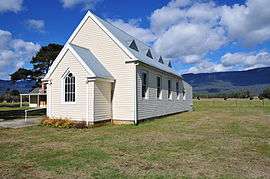Caveside
| Caveside Tasmania | |
|---|---|
 The "church in the paddock", Caveside's Church of Christ. | |
 Caveside | |
| Coordinates | 41°37′S 146°25′E / 41.617°S 146.417°ECoordinates: 41°37′S 146°25′E / 41.617°S 146.417°E |
| Population | 318 (2011 census)[1] |
| Postcode(s) | 7304 |
| Location |
|
| LGA(s) | Meander Valley Council |
| State electorate(s) | Lyons |
| Federal Division(s) | Lyons |
Caveside is a rural locality in Northern Tasmania, lying between the Great Western Tiers to the south and Mole Creek to the north.
It is a small community within an agricultural area, rather than a town. The town lies in an area of limestone; erosion of this has led to the surrounding land being riddled with caves. To the west are two undeveloped cave complexes, Wet Caves and Honeycomb Caves,[2] which are an attraction to cavers. The ground is pitted with sinkholes, a danger to the cattle that graze the fields. The district is probably named after the caves, though until 1897 it was known as Brookside.[3] Prior to settlement what is now developed agricultural land was dense forest. The timber and dairy industries are prominent parts of Caveside's rural history and it was known in the early 20th century for the quality of its cattle and sheep studs.[4]
History
Henry Reed became a significant figure in the early history of Caveside, after he took up a large land allotment in 1835. Reed conducted some early Wesleyan services in his home on the property known as Wesley Dale. He donated the land for the Wesleyan church with the intention that, when it was built, it was to initially be used as a school.[4] The first official Wesleyan services began c.1875 in a private home[5] that was sited in a paddock, near the bridge over Lobster creek.[4] Caveside Wesleyan church, and an associated cottage, was built and completed in 1876.[6] In 1903 the church became the Caveside Methodist church.[5] It was replaced with a brick church in 1978,[7] that is no longer open or used for church services.[note 1]
Caveside had a post office from 1887 operating from a private home.[8] It opened on the 1st of November and finally closed in 1980.[9] A private school opened, in the Wesleyan church, in Caveside on 4 June 1877 with 27 students. A single-room school building, and associated teacher's residence, was constructed over 1892–93. The school remained[note 2] in this building until 1937 when the school was closed. The school building was moved to Mole Creek in 1938 and used for 'domestic arts' at the Mole Creek district area school.[3]
Additional buildings were constructed on the Methodist church's land. These buildings included a cottage and two buildings used as a shop and a post office.[4] The shop and post office buildings were rented out from c.1900 to c.1940. A hall, noted for its fine timber lining, was built in 1921.[5] A public swimming pool, built with local volunteer labour, opened in 1957. It was extended in 1980 with the addition of a tennis court and in 2001 when gas barbeques were added.[note 3] The pool is a 16-metre (52 ft) outdoor pool and is managed by the Caveside Recreation Committee.[10] The shop has long closed but the Caveside memorial hall remains open and is operated by the Meander Valley Council.[11] The Church of Christ formed an organisation in the area in 1909. Prior to this services had been held in Caveside. They built a hand-split timber church building and opened it in 1911. The original building was moved in 1956 and a replacement built.[7] The building is now known as "The Church in the Paddock".[12]
Notes
- ↑ There is no church noted as operating in Caveside as of 2015, except for the Church of Christ.
- ↑ The school was for primary age children in grades 1 through 6.[2]
- ↑ Opening and expansion dates for the Caveside Swimming Pool are recorded on a commemorative sign erected in 2007 by the Caveside Recreation Committee
References
- ↑ Australian Bureau of Statistics (31 October 2012). "Caveside". 2011 Census QuickStats. Retrieved 30 April 2014.
- 1 2 Greenhill, p.76
- 1 2 Reunion Committee, p.15
- 1 2 3 4 "Looking back over a century at Caveside". The Examiner. Launceston. 21 May 1937. p. 6.
- 1 2 3 Reunion committee, pp.48-50
- ↑ "Wesleyan council financial district meeting". The Cornwall Chronicle. Launceston. 13 November 1876. p. 3.
- 1 2 Reunion committee, pp.50-51
- ↑ Reunion Committee, p.57
- ↑ Premier Postal History. "Post Office List". Premier Postal Auctions. Retrieved 16 June 2012.
- ↑ Northern Tasmanian Municipal Organisation Recreation Committee (January 2002). "Northern Tasmanian Regional Aquatic Strategy, Final Report" (PDF). Australian Sports Commission. p. 58. Retrieved 6 April 2015.
- ↑ "Halls & Community Centres – Information Sheet" (PDF). Meander Valley Council. Retrieved 5 April 2015.
- ↑ Liz Walker, "Church of Christ, Caveside", Meander Valley Gazette, October 2014, Meander Valley Online Inc: Deloraine., p.8
Bibliography
- Greenhill, Virginia (2002). In the blink of an eye. Westbury: Westbury historical society.
- Reunion Committee for the Reunion of Caveside and Chudleigh Schools and District (1994). As the lobster flows : Caveside-Chudleigh, an historical record. Devonport. ISBN 064618010X.